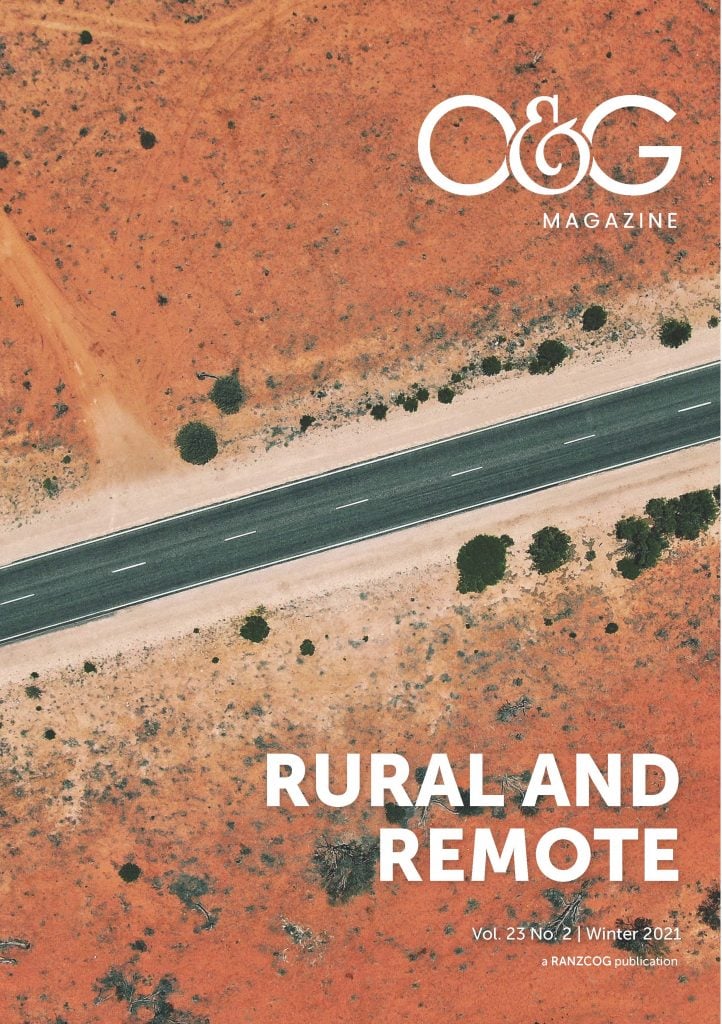My midwifery colleague leans over and whispers to me, ‘It is like we live and work in another country.’ We are currently sitting in the annual state meeting of clinical leaders in O&G. There are representatives from tertiary and smaller secondary city hospitals, a number of private hospitals and then us, representing 18 small- and medium-sized rural and remote obstetric units.
We have been discussing the different issues that each of us are facing across our health services. Some of the metropolitan issues are not as relevant to us, such as access to theatre or advanced laparoscopic equipment. There are also other issues that were once only rural problems, such as the syphilis outbreak in northern Australia, which has now become a state problem as it spreads south. We then have many common issues, such as staff shortages and the current ‘COVID-19 baby boom’ which is stretching resources, but often we have to deal with these problems quite differently.
While our city colleagues have to consider diverting patients to other hospitals or cancelling elective procedures, we have to contemplate quite different solutions. For example, there is no hospital we can bypass to in Kununurra, with the next obstetric unit over 800km away and across a state border. There are then many unique rural challenges. These include providing antenatal care for patients that live at least a two-day drive away from their closest hospital, the wet season and how it can close air strips and roads for months at a time and the challenge of providing termination services in small towns where ‘everyone knows everyone.’ In a world of subspecialisation, we also face the challenge of how we can train generalists and keep them skilled and able to manage anything that walks through the door, often with limited local resources.
In this issue of O&G Magazine, we invite you to take a trip with us across rural Australia and New Zealand to hear of these challenges firsthand. We invite you to set your alarm clock for a 4am flight with Dr Melville as she faces the challenge of providing termination services in rural areas and supporting the doctors in some of these smaller towns that risk their business and standing in the community by providing such services. Having seen the amazing sunrise and conquered any fear of flying in a small plane, we then head off on a helicopter from Thursday Island to provide antenatal care in some very remote areas. We will hear of the challenges Indigenous and remote women face when having to leave their family, traditional lands and support networks for ‘sit down,’ moving to a town that has a maternity unit in preparation for the birth.
We also hear from Kath Brundell and her team regarding how the distances women must travel to their closest maternity unit continues to grow, as smaller rural services are being closed down. With fewer rural obstetric units, Drs Roxburgh and Gardiner will then take us on a RFDS emergency flight to pick up a woman labouring in a rural area, discussing the challenges of trying to decide ‘do we put this patient on a plane and risk a mid-air birth, or deliver them here with limited resources?’
Noting that we need more rural obstetric doctors, Dr Moore and her team will discuss the challenges of training and supporting GP obstetricians who can literally provide ‘birth to grave’ healthcare in rural areas. With the push for subspecialisation in all areas of medicine, Prof Permezel will explore the challenge the College faces in how to train rural general O&G specialists, such as A/Prof Pettigrew, who will then tell us about his 30 years of being a rural O&G and why you should ‘head bush’ with your career.
We sadly know that rural and Indigenous women have poorer health outcomes for many reasons, including access to healthcare and many social determinants of health. Therefore, as you make your ‘covid safe’ trip around rural Australia and New Zealand, we ask each and every doctor and midwife, irrespective of where you live and practise, to consider what you can do to help address this large disparity in health outcomes for rural women, their babies and families. While we are always looking for more ‘bush doctors’ who are up for an amazing adventure such as Dr Erwin describes in her article, we also are very appreciative of our city colleagues who are there to pick up the phone when we call. For our metropolitan colleagues we ask you to consider being a ‘city-based bush champion’ which means considering what you can do, wherever you are, to improve obstetric and gynaecological outcomes for rural women.
There are many ways you can be a city-based bush champion. This may include becoming involved in telehealth, as discussed by Dr Williams, so rural and Indigenous women can access your specialised knowledge and skills. Maybe you can think about spending a week or two out in a rural area, sharing your subspecialist skills with rural doctors and patients. You could give a lecture to the RANZCOG Regional Fellows group, invite a rural doctor to come and upskill with you in the city or just appreciate that things are often challenging in rural areas and give positive and supportive advice on the phone, especially when things may not have gone to plan.
Being a city-based bush champion can also involve sometimes ‘bending the rules’, such as accepting a direct admission for a remote Indigenous patient, that yes, maybe could just have an outpatient appointment. But for many remote Indigenous women, where English might be a third language, they are already fearful coming to the city and with added challenges such as finding their accommodation and meals, they may not come at all, or make their way back home quickly.
We also love ‘one stop shops’ for our rural patents so they do not have to make multiple trips up and down to the city. If you see a referral for a rural patient that will likely need a hysteroscopy, consider blocking off a spot on your theatre list the same week or squeezing her on your list the following day. Each time she comes to the city will mean more time off work for her and her partner, extra costs associated with the travel, needing to find childcare and all these additional factors can often stop women accessing care.
Finally, if you are involved in policy development, always consider how a state or national policy will affect rural women and their access to health services. They are already some of the most vulnerable women in Australia and New Zealand, with limited access to healthcare.
An example we have seen of this is the mandating of the number of TVTs a surgeon needs to perform each year. With the implementation of this policy Australia wide, we saw the treatment option pretty much removed for many of our Indigenous and remote women. Many regional gynaecologists, who had performed this surgery for many years and audited their results, were stopped as there were not the numbers required in their local area. Many patients, in particular Indigenous women, do not want to travel to the city to have such procedures performed. Reasons include family responsibilities, fear of the city, extra costs or loss of income. Many rural specialists, including myself, have tried to organise local lists of TVTs for a certified visiting surgeon to come up and perform. We then faced the challenge of trying to get all the patients to the same hospital, on the same day. For our two attempts, this was thwarted by unexpected rain cutting off the road out of a remote community, ‘sorry business’ for another two patients, the greyhound bus being late once and then cancelled the second time and a patient being unwell on the day.
It is common for us in rural areas to have large ‘did not attend’ rates for our outpatients and theatre lists because of the weather, remote travel difficulties and the cultural needs of our patients. While we appreciate the TVT policy was designed to protect women, it has neglected some of our most vulnerable patients, by being applied to all city, regional and remote areas the same. Urogynae services, including pelvic floor physiotherapy, are extremely limited in rural areas, with many patients forced to wear incontinent pads all the time. We therefore need to carefully consider any similar future policies, such as for advanced laparoscopic surgery, as to how any such policy would affect Indigenous and rural and remote women’s access to the service and treatment options.
Therefore, while we cannot easily travel at present, we hope you enjoy this issue of O&G Magazine, as it provides you an opportunity to take an armchair trip to rural and remote areas of Australia and New Zealand that often can ‘seem like a different country.’ Hopefully it will inspire you to think about rural O&G in your everyday practice and even better, inspire you to come join us for a few days, a couple of months or even a whole career! See you out bush soon!






Leave a Reply